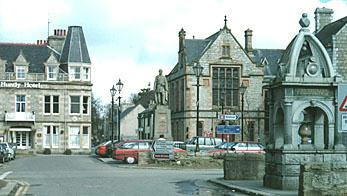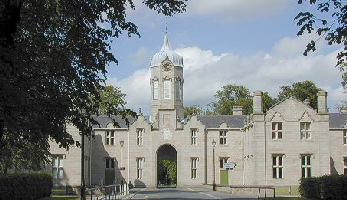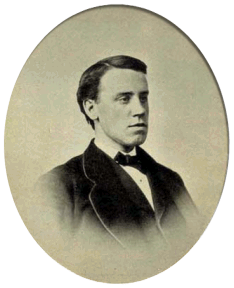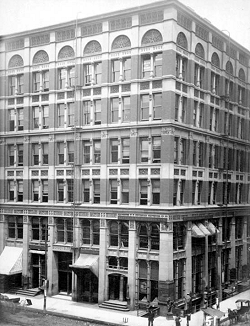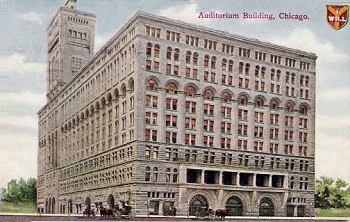 |
firm active: 1907-1921 minneapolis, minnesota :: chicago, illinois |
Review of Gebhard Thesis
Editor's note: In most places, this section of the manuscript is written directly in the first person by Purcell to David Gebhard, and contains critique citing specific pages in the Gebhard thesis, together with references to Frank Lloyd Wright's Autobiography.
<page 1>
George Grant Elmslie - Part I. (May 17, 1955)
HUMAN RELATIONS In the long road of eighty years a person has been many personals. What remains constant as the unique self and what it is that changes, and how, is the biographer's hard problem. I AM OF COURSE unacquainted with George Elmslie's austere deport- ment toward callers reported by you and others in his last years. Shouldn't it be made clear that his withdrawal and aloofness were a "tendency" which only gradually became noticeable after his retire- ment from active business? In some constructive way could you per- haps leave it to be inferred that this was the index of old age, rather than a normal characteristic of the man in health? After the death of his wife, Bonnie Hunter, there always was a tendency to withdraw into the closed circle of his adoring sisters. He had nowhere else to go. However, his relation to people during <page 2> the years while he was in business for himself - draftsmen, contract- ors, client - was a pretty normal daily business adventure. Some- thing could be revalued for your continuity without going into unprof- itable details. GGE's EDUCATION The best schools of Scotland carried their scholars in eight years further into the mental levels of high school and college thought than did the American public schools of that day. In both countries a solid grounding in the three R's was taken for granted. It was in literature, history, science and higher math- matics that the Scots demanded solid work from teenagers and they got it. GEORGE ELMSLIE came to the United States in the fall of 1884 at the age of fourteen, having spent the previous four years in the very dis- tinguished Gordon Schools at Huntley, Scotland. His elementary school- ing was had at a parish school. He did not seek further schooling in America, but upon arrival in Chicago he secured a position in an architect's office. We do no know whose. He continued his cultural studies at home in Latin and mathematics, working with his sister Louise. He was enthusiastic over his job and did drawing and drafting at home. He was employed by Mr. Silsbee from 1887 to 1889. At the sug- gestion of Frank Lloyd Wright he applied for a position with Adler <page 3> and Sullivan and was accepted early in 1889, when Sullivan was still in the Borden Block at Randolph and Dearborn Streets. After about two years there he moved with them to the new Auditorium Tower in the spring of 1890. MIDWEST DESIGN 1865 - 1893 A 1955 book title reads "Man Is Not An Island." For some years Sullivan has been the outstanding personality in the days of the great transition in world culture under the impact of the machine. This has tended to obscure evalua- tion of the people and events by which he lived and grew. WHAT YOU SAY ABOUT Silsbee and his office leaves out the charac- ter and influence of a considerable amount of architectural designing, to which little attention has been given. When it comes to be apprais- ed, especially if it is done before further buildings of this era disappear, such studies will certainly change critical opinion. So watch out here, Dave, and don't get out on a limb in too general con- clusions from too little data. I am referring particularly to such architects as Charles C. Miller, who did Dr. Gray's first house in 1874, at 418 South Boule- vard in Oak Park. Miller's second house for our family was for Frank S. Gray, his son, in 1883. He did a third house, for Dr. Gray; the Kenilworth Avenue house of 1890; and then a fourth Miller house, for my father C. A. Purcell, northeast corner of Forest Avenue and Erie <page 4> Court, in 1893, still standing but very badly mauled by extensive remodeling. I hope to develop a critical placement of these houses in pre- Columbian Exposition American Architecture; they are all interesting and significant. The design details of this time were carried through- out the country in the Contractor's Magazine. Miller's work was ex- cellent and a contributing factor in a very large volume of work over a twenty-five year period of transition, 1870-1895. I have a full list of Miller's office addresses in Chicago - must be two dozen - from 1867 to 1901; but the town was growing with many ups and downs in business and too much hard drinking by too many architects. I saw a newspaper picture the other day of a corner bay window here in Los Angeles built around 1886. The top of the corner tower, oblong in plan, looks as it if had been lifted from early Sullivan design or vice versa. This Los Angeles house is related to the things that Miller was doing, just as "early" Sullivan design was related to Miller (or vice versa). See "Sullivan-like" front porch of C. A. Purcell house of 1893. I'll send you a print of this. You will be interested to note how closely this wooden porch with its patterns and sawed ornaments is related both to the design vernacular that Sullivan was doing just before the Chicago World's Fair and the decorative material which appears on all Miller's buildings. There is a large area for research here and some one should do it. Again you should be careful not to get yourself tied by visual appraisals. <page 5> Too quick conclusions might be drawn which could wash out later. Do you think that perhaps you over emphasize the Queen Anne "Style?" I think what you are talking about was pre-Queen Anne. I think the Gray House on Kenilworth Avenue characterizes this bet- ter than the references to Queen Anne, which after 1892 was called "English," "Elizabethan," or "Half timber" - this all before William Morris and Lethaby appeared in the U.S.A. around 1900 with their plain plastered walls, rows of gables with rows of diamond glass windows and, shocking to suburbanites, "no basements and no front porches." I can well remember the very first comings of the "Queen Anne" talk and people making jokes about it. I would have been at least six or seven years old before I could have understood what they were talking about. So I should say that it would be about 1885 to 1888 when the Queen Anne style in the suburban West really got around enough for people to talk about it. Remember there were few publish- ed pictures of what was going on. There were a few in builders' trade journals, but these did not reach people generally. And by "style" people meant "fashion," not what critics now mean by style. "WRIGHT ON WRIGHT" (Joseph Henry Jackson) You say, "Wright's description of Elmslie gives a clearer insight into Wright than it does of Elmslie," which is of course true enough. <page 6> WRIGHT'S CHARACTERIZATION of Elmslie is too general and repre- sents too much his own self-centered point of view. (Your reference, F.L.W. Autobiography, 70 "stupidity" and "brutality.") Well, stupidity and brutality is found today and a whole lot of it. But there was much very interested and very lively work at that time. Some of Wright's own detail of 1892 is feeble. See ceiling sawed ornament of his own house (southeast corner, Chicago and Forest Avenues). Where he stuck close to Sullivan, he was on firm ground. Wright was at that time a "disciple," much as he now would discredit all such. Design certainly wasn't stupid and brutal as what began to happen immediately after the Chicago Fair of 1893 when the Classic pastiche took over. Go back and have a look at McKim, Mead, and White's drawings and illustrations, beginning about 1896, in the Architectural Record and Review. I think that you'll be surprised as I have been to see how much that was was over-rated in its day. In the light of what is being done today, McKim, Mead and White just look too much like the dilettantes they were. Page 2, Paragraph 3: You certainly can't take Wright's adjectives as an realistic picture of George. George was not tall. He was a bit shorter than I am; I am six feet. He was not slim; he was quite a normal build. And as for "slow thinking," that just simply isn't sp. He was a man of quick imagination. His mind in architecture was articulate, succinct and competent. How ever lush his ornament, he <page 7> never lost control of it. His running talk never got heavy and he was always ready to respond. He was not a long distance talker, but he was by no means a silent person. He gave a lift to every evening fireside conversation. My Grandmother Gray was a very lively person and she and George always had a good time when they got together. Grandmother said George was witty - that was the word in those days. Our family was Scotch [sic] and so we always had a lot of Scotch [sic] talk, Scotch [sic] jokes and general good humor. It was a strange coincidence that George and I were both of the Grant clan; he of the third, I of the fifth generation. Wright's object in his autobiography is to look down his nose at George Elmslie; in a kind of sly way he deprecates George to deflect attention from the less than admirable circumstances that separated himself from Adler and Sullivan in 1894. The designation "faithful" by Wright is a kind of sour compliment to discount by association Wright's own unfaithfulness. Well, George Elmslie wasn't faithful because he set out to be, or because he had to be; he was just a natural, ordinary, honest-hearted guy. He was naturally faithful because that was the thing that decent people were. He was a little what is popularly called diffident, but I like to old Scotch [sic] word "bashful;" that is to say "shy, modest, sensitive;" that is it. Diffident, says Webster: "lacking in self-confidence" (dis-fides)" well, there was certainly none of that. And he wasn't too quiet, even in the office. He was ready to talk and laugh. He was always <page 8> very popular with our draftsmen and all those of the building business- es who came in. A very likeable, pleasant man; nothing withdrawn and aloof about him, no egotism, just a good Anglo-Saxon democrat. The Scotch [sic] background of both George and myself was one of the factors which also bound us together. Were brought up in the Grant- Cunningham-Woods-Gray tribe of Scotch-Irish, had Robert Burns recited to us, were taken every year to the Burns anniversary celebration held in Chicago on January 25th. It was in attending the Burns birth- day of 1890 at the Chicago Auditorium when it was first opened that I got my first view of that building. Yes, George Elmslie was modestly conscious of his heritage and even superior over more of his fellow practitioners. George was justified in so thinking. He knew what he could do and he did it. It is significant that in his autobiography Wright shows a plan of the Adler and Sullivan offices in the Auditorium Tower. That east office, where I later worked at Wright's table, he [F.L.W] labeled "Mr. Wright's office." That wasn't Mr. Wright's private office; that was the office used by Wright and Elmslie. It wasn't any more Wright's office than it was George Elmslie's office. Wright was not the director- ing, supervising chief draftsman in the office. George had just as important a table in that room as Wright did. Wright's table was against the south wall and George's drafting table was against the west glass partition, with just enough space at the right side of his table to pass through the glass door there and along the north side <page 9> of the long rows of drafting tables. This dual situation discounts a number of comments that Wright has made with respect to his own relation to the Adler and Sullivan office. Many things he reports could hardly have been the case, because as the office was arranged, it would have been impossible for him either sitting down, stand- ing up, or even stepping to the door to see the things that he re- ported as occurring under his eye in the drafting room. I've gone into that in other places in my writings. I can go into it with you if you want me to do so. A quick example is his account of the fight and "stabbing." George was there. Wright's account is blown up out of all relation to the event. -oo00oo-
NOTE: If considered important to students of this era more exact and complete date on the early years in which Mr. Elmslie began his career in architecture will be found in Elmslie's very extensive correspondence. These letters are a few running history of archi- tectural thought during the transitional era of the Machine Age and several hundred of them will be found on file in the Purcell and Elmslie Archives. Students would also find most interesting the story of the found- ing of these Gordon Schools by Lady Gordon with buildings and endow- ment for young Scots of all classes of society, free of any expense whatsoever.
Something new: The images, notes, and links added here are for visual reference, and do not appear as part of the original manuscript. Links open new browser windows or tabs to keep your place.
Huntly Square
Huntly, Scotland
Image credit: The Gordon Schools website
Gordon Schools
Huntly, Scotland
Image credit: The Gordon Schools website
Joseph Lyman Silsbee
1848-1913
Borden Block
Adler & Sullivan, architects
Chicago, Illinois 1879
[demolished 1916]
Penny postcard
Auditorium Building
Adler & Sullivan, architects
Chicago, Illinois
- George Grant Elmslie - Part II. (May 25, 1955)
Collection: William Gray Purcell Papers, Northwest Architectural Archives, Correspondents, David S. Gebhard [C:124]
